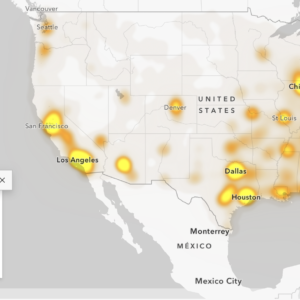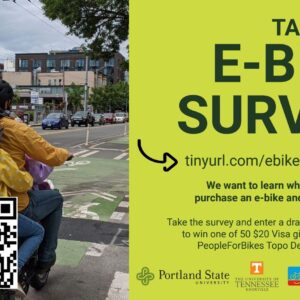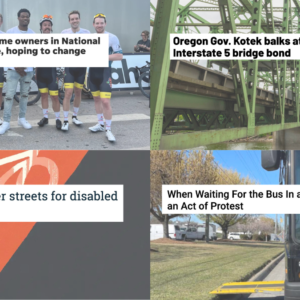Portland’s favorite pedaling politico got his views on biking into the hands of 72.6 million Americans on Sunday.
Rep. Earl Blumenauer (D-OR) was featured in a Parade Magazine column titled “Greener Commute”.
In the article, he was asked three questions, including one that featured Portland:
Your city—Portland, Ore.—is very bike-friendly. What has worked?
We have expanded the number of bike lanes, established bike routes throughout the city, and turned major streets into “bike boulevards” so there is less through traffic. It’s making a huge difference. People in Portland use their cars much less than the American average. That translates into savings of more than $2500 per year per family. There should be a bicycle master plan for cities large and small.
Another question gave Blumenauer the opportunity to make a few key points:
How do you balance the competing demands of cyclists who want more lanes and drivers who worry about congestion?
It’s not about competition. Cycling actually helps improve traffic flow on roads. If all of those thousands of people who bike every day in Portland were to get back in their cars, we would have more traffic congestion and more frayed nerves. Cycling helps with parking, too—you can fit a dozen bikes in the space one car would take.
Also, as to be expected with any mention of the merits of bikes in a large, mainstream publication, one comment at Parade.com asked; “How do you get your bike riders to obey the law?” I wonder what Blumenauer’s response to that would be?









Thanks for reading.
BikePortland has served this community with independent community journalism since 2005. We rely on subscriptions from readers like you to survive. Your financial support is vital in keeping this valuable resource alive and well.
Please subscribe today to strengthen and expand our work.
Also, as to be expected with any mention of the merits of bikes in a large, mainstream publication, one comment at Parade.com asked; “How do you get your bike riders to obey the law?” I wonder what Blumenauer’s response to that would be?
I suppose you don’t think the issue of cyclists disobeying basic traffic laws (stop signs and stop lights) isn’t a problem worth addressing?
I suppose you don’t think the issue of cyclists disobeying basic traffic laws (stop signs and stop lights) isn’t a problem worth addressing?
you suppose wrong. of course that’s an important issue. what makes you think I believe otherwise?
I was merely pointing out how often that response comes up, no matter what the content of the story is.
I think Earl’s answer would be:
“We use the same techniques used to eliminate speeding and other ubiquitous traffic violations by motorists.”
J, I think cyclist is mentioning this because the article as it stands right now on the blog cut off Earl’s third answer. I think you probably posted it but it didn’t show up?
This is a nice article and not much longer than what Jonathon posted (any problem with simply posting the whole article, just curious).
As for the comment referenced above, here it is in its entirety:
“The cyclists in my city constantly break the law. They run stop signs and traffic lights, go the wrong way in lanes and on one way streets, don’t use lights at night, and won’t yield to other traffic. They believe that they are pedestrians because they are foot powered, and believe that cars must stop for them. This is not the law here (bikes are vehicles here).”
I have often wondered if people run stops signs, etc. on bikes because they view their surroundings more like a pedestrian than like a motorist.
Did anyone see the print version of the Parade article. If so, how prominent was it?
How about this, “By and large cyclists do obey the laws. Like motorists, we do have a very small number of selfish individuals who feel the laws do not apply to them. If they break the rules of the road then they should face the same penalties as bad drivers. That is why law abiding cyclists and motorists applaud and support the efforts of law enforcement to make our roads safer for all.”
That hits all of the high points and deflates the gasbags. Personally, I’ve taken the wind out of some pompous sails with that statement.
Brad- I like your response. Goes to the there are considerate and inconsiderate folks (I initially used another term). Their mode of transportation is a secondary consideration, so to speak.
Here’s the link:
http://www.parade.com/news/intelligence-report/archive/a-greener-commute.html
Brad (#6) – I wonder if that’s actually true, though. There are many days where I distinctly feel like I am in the minority because I yield to pedestrians, stop at stop signs, stay in the bike lane and travel in the direction of traffic. I know I’m not the only one, but has the city or any other authority ever done a proper study of compliance?
NYC did, and found that the majority of cylists are breaking their traffic laws. I’m curious to know if the same would happen here.
Why is it that, even though 35,000+ people are killed on the roads every year, nobody ever asks the question: “how do you get motorists to obey the law?” or even, “what percentage of motorists break the law?”
Brad– Here in Boulder CO I sadly believe that the majority of the cyclist do disobey the law at varying degrees. Some “just” run a stop sign (when no cars are around) to some riding the wrong direction on the street at night with no lights. I wonder how much of a problem is illegal cycling in more cycling established communities? (I’m thinking of Europe/Asia)
andy (#9) – 40,000+ (typically 43k-44k), and that’s a very good question. One wonders, why are *people* breaking the law (have you SEEN how pedestrians act?), and what can we do, if anything, to change that? Should we even try?
And before the crowd of responders answer “of course we should try”, ask yourselves this – are you willing to live in a police state to ensure others follow the law? Who will pay for it? Who decides the law? There are no easy answers, and absolutes don’t work – because their are always exceptions and frequently extenuating circumstances.
Earl’s response to the question “How do you balance the competing demands of cyclists who want more lanes and drivers who worry about congestion?” was “It’s not about competition…”
Earl got it exactly right, of course, but the framing of this question betrays a very popular misconception – people want to believe that everything cyclists get has been taken away from motorists; i.e., it’s a zero-sum game.
In Portland, anyway, this is clearly not the case. On a very quick check of bike lanes around the City of Portland, I can find about 7 miles’ worth that involved removing parking from one side of the street. Another 7 miles involved “road diets”, or lane reductions. That’s 14 miles out of a total of 180 miles total -or, less than 10% of bike lanes have involved any sort of conceivable “takeaway” from motorists.
It’s worth noting that in the case of the road diets, the road capacity was not really needed by motor vehicles, and little if any congestion has resulted; similarly, the on-street parking was geenrally lightly used, in residential areas with sufficient off-street parking.
For some details about numbers and stats on people who violate traffic laws (both bikes and cars) turn your attention here:
The Myth of the Scofflaw Cyclist.
http://washcycle.typepad.com/home/2008/07/the-myth-of-the.html
It is an interesting article that seems to get to the heart of the matter.
Enjoy!
Scott…you produced a website which states a bunch of numbers and prevalences without one, single, reputable source/citation…
that is commonly referred to as “junk science”….
believe the conclusions drawn from it can only be spurious and misguided at best…sorry, nice try though.
and Andy…your post makes it sound as though 40,000+ vehicular deaths are all attributable to breaking the law…which they are not. many are accidents, equipment failures, etc..
please folks…start comparing apples to apples without providing unsubstantiated one-sided political propaganda….
its like linking helmet advocates to a single research report (which is extremely methodologically flawed) that found drivers driver a mean 5cm closer to riders with helmets…as if an average actually means anything when a car hits you….
Bahueh,
He actually links to his sources / citations. They seem relatively reputable to me…if you can believe the government 😉
Speaking of unsubstantiated one-sided political propaganda, always love your posts bahueh.
You mean the peer-reviewed publication in the Journal of American College Health cited for the proposition, based on empirical observation, that drivers fail to obey stop signs adjacent to pedestrian crosswalks on college campuses is “junk science”?
Don’t you have some junk science of your own to substantiate your statement that “many” of the 40,000+ deaths caused by people driving motor vehicles in the US each year are caused by “equipment failures”?
Matt (#8)
I had no idea NYC did that study. Would you post the link?
Velo Vanguard..try actually reading what I wrote…then comprehending…then thinking about it…
in that order, preferrably….
junk science? yes….one area was observed and recorded is hardly representative of the entire country, now ain’t it…
do you really need me to explain this to you? seriously?
VeloVanguard…college campuses are hardly representative of larger infrastructure networks either…
oh, nevermind….what you respond with isn’t worth the time..
velo vanguard and bahueh,
your back-and-forth is slipping toward mean-spirited sarcasm. Please keep everything above the belt. thanks.
Maus, when some guy on your site starts spouting off that a ‘webblog’ is a reliable source of well measured data collection…I’m going to speak up…
as should you.
the reviewer process for the American Journal of College Health has…as we sometimes say in the medical professional….weak arms.
I’m not sure we read the same website, Bahueh since, as was pointed out, most numbers the author used were cited and from what I consider reputable sources (NIH, Traffic Safety Research Division of the Federal Highway Admin, DC Department of Public Works, DC Metropolitan Police Department, Virgina Court Records, US Dept. of Transportation, University of Utah Applied Cognition Laboratory (many published and peer-reviewed articles)…).
There was anecdotal evidence in the article as well, but I don’t believe the bulk of the article could be considered to be founded on “junk science.”
Can one study done in one part of the country conclusively be described as “proof?” Of course not, but as with all science, these studies can take us closer to a better, broader understanding of an issue or phenomena.
It isn’t constructive to discount a study as “junk science” if some of the variables may be different (though it is important to be mindful of the limitations all studies have). You can never control every aspect of a study, nor measure every output/outcome. Inferential statistics, demographics, ethnographics, etc. can all help us make reasonable generalizations out of a finite set of data.
Perhaps you can add something more constructive to the conversation than chastizing me to compare apples to apples, criticize my source (which seem legitimate to me), or accuse me of spurious or misguided because I believe the conclusions with sarcasm. “Sorry, nice try though,” doesn’t forward the conversation.
The conclusion to me seems rather sane and well put:
“The premise that cyclists’ behavior somehow voids their right to sharing the road is indefensible. . . This becomes an increasingly difficult premise when one considers that, as I’ve tried to point out, that cyclists aren’t behaving any differently than drivers or pedestrians. They’re taking liberties with law where they think it’s safe to do so. Right or wrong, that is what every class does.”
Is it really so misguided or spurious for me to believe that?
Thanks!
Biking Viking (#18) – Elly Blue posted in in the Monday roundup: http://bikeportland.org/2008/11/24/the-monday-roundup-3/
Look for the NY Times item just below the advertisement.
Bahueh, I understand the peer-review process, having published scientific articles in peer-reviewed journals myself, and I have reviewed the sources cited in the article linked by Scott, and I stand by my statement that it was simply wrong for you to assert that the article is “without one, single, reputable source/citation.” Perhaps we’ll have to disagree about what counts as “reputable,” but for your assertion to be true you’d have to show why each source cited in the article is disreputable. Can you do that??
Additionally, I find it ironic that you made a purported statement of fact that was unsupported by *any* citation when you said that “many” of the 40,000+ deaths caused by people driving motor vehicles in the US each year are caused by “equipment failures.” Where did you get that information?
Finally, I agree with Scott on two counts: First, the tone of your post doesn’t forward the conversation. Perhaps mine didn’t either but, IMHO, this gotcha personal style post really seems to be SOP for you. Maybe you could have critiqued the review procedure for the Journal fist in lieu of the “Sorry, nice try” sarcasm?
Second, the conclusion of the article seems rather reasonable and well-stated to me as well — I see people in motor vehicles, on bikes, and on foot *all* breaking traffic laws. That cyclists are the “scofflaws” (as opposed to other groups) seems to be more about bias than fact. Are there “reputable sources” to dispute that?
Seriously, did you read the article and check out the sources?
The Blumenauer Q&A ran in one column on page 7 of the magazine in a “Newsmakers” section. Not mentioned on the cover, so a little bit buried. BUT, this is a national publication that tons of Joe-Six-Packs and soccer moms read — it’s a very “mainstream” readership of Sunday paper readers. That alone makes it a big coup for Earl and for bicycling.
Last saturday when I was driving on the freeway at the 55mph max speed limit, EVERYBODY was passing me. Some of them blasted by me like I was standing still. They all got away with it too.
Should I conclude that all drivers are law breaking scofflaws? Or should I just get with the program and follow the example of everyone else, by speeding as well.
I think that the article Scott pointed out can help one understand why those who complain about the scofflaw cyclist are likely to behave in a similiar manner when astride a bike.
Many of the laws cyclists break were put in place specifically because safety and size concerns of motorcars.
Take away the motorcar and you would need many, many, less stop signs, signals, speed limits, parking signs, pavement markings, etc.
I will bend the law when it is expedient, safe, inconspicuous. I believe it is just and sensible for me to do so and I am willing to take responsibility for that decision.
I wonder how rep. Blumenauer gets his motorists to obey traffic laws?
How about answering it: Bicyclists are no different than other segments of society. Just as many motor vehicle operators drive above the speed limit on our highways and roadways and roll through stop signs, so to do many bicyclists “roll” through stop signs. IF we wish to compare I think it would be safe to say that a many more(a majority?) of bicyclists stay within the speed limit as compared to automobile drivers. 🙂
Great thread, everybody. I think we all agree (well, all minus one) that people mostly know how to get around in traffic, and the fewer signs, the better. A couple of points, though. In general, the reason that people fail to comply with signals is that those signals don’t function right, and the people know better. This is mostly true at reasonably designed sections of road. Where it falls apart is on divided highways, where all visual cues (aside from the posted speed signs) reinforce the feeling that you should go as fast as you can and it’s still safe. Add that to the marketing of cars with excessive horsepower and cocoon-like isolation, and you wind up with the majority of people making the wrong judgement about safe speeds. This situation has no analog in cycling. The average person operating a bicycle is aware of his/her safety envelope, and controls it reasonably. This is irrespective of whether they happen to be in compliance with posted laws.
Thus, even though all groups of vehicle operators violate the traffic laws, it is much worse when motorists do it, because they are operating under a false sensation of safety, while cyclists generally are not.